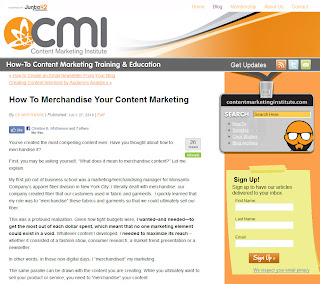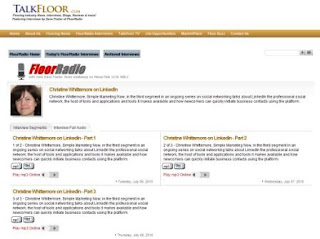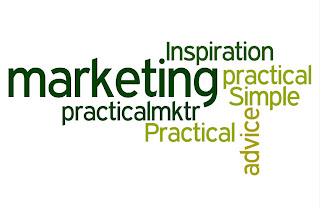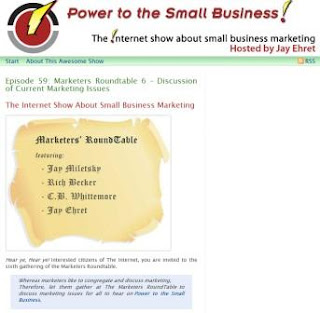TalkFloor's Dave Foster and I continue to explore social media marketing. From
Advanced Twitter, we have moved on to
LinkedIn.
Before I go further, are you on LinkedIn? How do you use LinkedIn? What do you like most and least? I'd love to hear.
Both Dave and I are on LinkedIn. I invite you to connect with us. Here are links to our profiles:
Dave Foster
Christine Whittemore
Of all of the social networks, I've been on LinkedIn the longest having joined shortly after it was launched. However, it's also the network that has taken the longest to evolve beyond a resume posting site into an actual social network with interesting and useful interactive resources. Dave and I explore some of those features in the
following TalkFloor interview about LinkedIn which you can access by clicking on this link.
Dave describes the three-part interview as follows:
Christine Whittemore, Simple Marketing Now, in the third segment in an ongoing series on social networking talks about LinkedIn the professional social network, the host of tools and applications and tools it makes available and how newcomers can quickly initiate business contacts using the platform.
Here are shownotes and details relating to our discussion about LinkedIn.
What is LinkedIn
It's a professional social network, launched in 2003, which now claims
70 million members in 200 countries in all 7 continents.
Demographics:
- 72% college grads
- 66% over $60K/year
- 68% 35+ years old
Visitors to the site have jumped 31% from last year to 17.6 million in February 2010. Every Fortune 500 company is represented and 81% of business-to-business marketers use LinkedIn.
Here's what I find particularly valuable: new networking functionality has been recently added - particularly as it relates to groups [for more information read:
Welcome to a whole new way of experiencing LinkedIn Groups]. Pretty exciting!
LinkedIn used to be quite static – primarily a place for resumes. Although it is considerably more interactive, LinkedIn is a much calmer, corporate like environment compared to Twitter or Facebook. It's a wonderful environment for keeping track of people you know and connecting with people you meet professionally. It's valuable for networking, researching and connecting for business purposes.
What's important to remember is that search engines such as Google like LinkedIn profiles. If you have a LinkedIn profile and Google yourself, you'll notice that your profile appears prominently on page one of search results, making it an important element of your personal and professional brand reputation management. Manage your profile and control what people find about you and your company.
Within LinkedIn you can search people, companies and groups. You can see how you are connected to others; you can learn more about the person you’ll be having a business meeting with and have a more productive session. You can also send personal messages.
What to do first on LinkedIn:
Definitely, your personal profile. Set it up; complete it 100%. Add a photo, import your contacts and browse through your connections’ connections to find others you know. LinkedIn will also suggest people for you to connect with. NOTE: when you invite others to connect with you, be sure to customize the invitation so it sounds like it came from you. This makes a difference!
Once you have your profile created, be sure to
claim your vanity LinkedIn URL [e.g., mine is CBWhittemore]. To do so, go to settings/public profile; you'll see the prompt to customize your LinkedIn profile URL. Be sure to note the other options available.
I recommend that you look into several neat features that LinkedIn offers for enhancing your personal profile: You can add a feed from your blog. Embed your Slideshare presentations. Add link to files like resumes and marketing kits [via Box.net].
To find these applications, on the LinkedIn Nav bar, look for MORE – you’ll notice many options including the apps directory. [Others include: polls, private collaboration space, track travel via TripIt..]
How to increase your LinkedIn visibility:
Definitely complete your profile. Include in your profile links to your website, blog, etc. Be sure to use relevant keywords in your headline, your current experience, your summary, your specialties... Don't forget to issue status updates on a regular basis.
Note: your LinkedIn updates can be connected to your Twitter account.
- Consider creating events in LinkedIn to raise awareness for what you are doing.
- Definitely, recommend others and request recommendations [again, be sure to customize your request message].
- Explore the other valuable LinkedIn features.
Other valuable LinkedIn features:
LinkedIn offers several features for interacting with others:
LinkedIn Answers: a Q& A Forum. Per a report in
Business.com in Dec. 2009, 59.2% of companies and 79% of B2B organizations who participate in online business forums use LinkedIn Answers.
LinkedIn Groups – over 500,000 based on companies, schools, affinities…
Do a search and see what comes up [Note: simply select groups in the LinkedIn search window; it defaults to people]. As it relates to Flooring, you'll notice 109 currently. Most popular ones appear first. Check them out. Consider creating your own about a subject you are passionate about.
NOTE: It's critically important to moderate and be actively involved in your group to ensure quality of content and high level interaction [i.e., no spam]. I give the example of
HIMSS' best practices : moderate, post guidelines, educate about policies, ask questions, followup, interact, keep it fresh and relevant.
How to use LinkedIn for business?
In addition to your personal profile, you should also be sure to claim your business profile. There, too, you should use keywords. You can now track companies of interest – new feature – find out when they move locations; upcoming big events; new employees…
I recommend that you integrate LinkedIn into your other activities online and offline. For example, on your website, add link to your LinkedIn profile on your about us page. When you meet new people, connect with them on LinkedIn. Add a link to your LinkedIn profile in your email signature. Include a reference to it on your business card.
Demonstrate thought leadership by participating in LinkedIn Answers: ask questions/provide answers – Caution: don’t shamelessly self-promote! Find relevant groups to contribute insights to. You can also use LinkedIn’s DirectAds to push relevant ads to LinkedIn subscribers targeted by profile demographic info.
For more information, check out
LinkedIn’s Learning Center [click on More in your LinkedIn navigation menu], the
LinkedIn Blog,
MarketingProfs has put together a case study collection, and see the resources below.
Here's your LinkedIn assignment:
- Set up your profile
- Complete it 100%
- Invite people to join both from your own email list as well as by checking out connections of connections
- Explore groups and join one.
- Update your status on a weekly basis
LinkedIn resources for you:
What LinkedIn questions do you have? How do you make LinkedIn work for you?
Next: Getting practical with LinkedIn.















